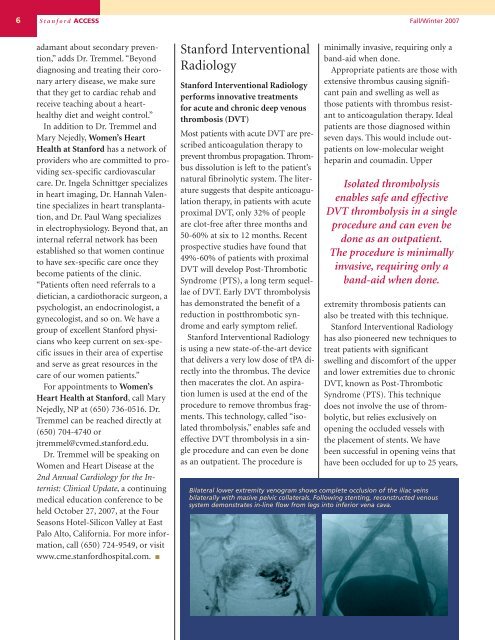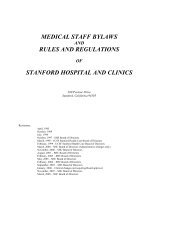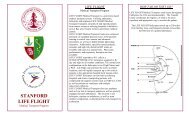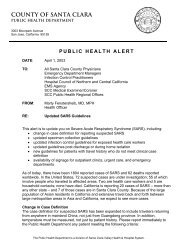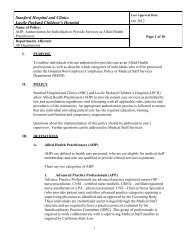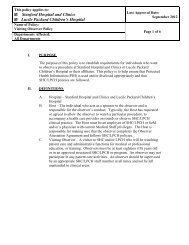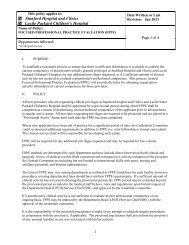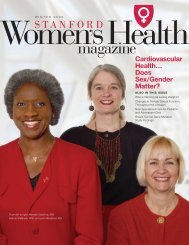Fall/Winter 2007 - Stanford Hospital & Clinics
Fall/Winter 2007 - Stanford Hospital & Clinics
Fall/Winter 2007 - Stanford Hospital & Clinics
You also want an ePaper? Increase the reach of your titles
YUMPU automatically turns print PDFs into web optimized ePapers that Google loves.
6<br />
S tanford ACCESS <strong>Fall</strong>/<strong>Winter</strong> <strong>2007</strong><br />
adamant about secondary prevention,”<br />
adds Dr. Tremmel. “Beyond<br />
diagnosing and treating their coronary<br />
artery disease, we make sure<br />
that they get to cardiac rehab and<br />
receive teaching about a hearthealthy<br />
diet and weight control.”<br />
In addition to Dr. Tremmel and<br />
Mary Nejedly, Women’s Heart<br />
Health at <strong>Stanford</strong> has a network of<br />
providers who are committed to providing<br />
sex-specific cardiovascular<br />
care. Dr. Ingela Schnittger specializes<br />
in heart imaging, Dr. Hannah Valentine<br />
specializes in heart transplantation,<br />
and Dr. Paul Wang specializes<br />
in electrophysiology. Beyond that, an<br />
internal referral network has been<br />
established so that women continue<br />
to have sex-specific care once they<br />
become patients of the clinic.<br />
“Patients often need referrals to a<br />
dietician, a cardiothoracic surgeon, a<br />
psychologist, an endocrinologist, a<br />
gynecologist, and so on. We have a<br />
group of excellent <strong>Stanford</strong> physicians<br />
who keep current on sex-specific<br />
issues in their area of expertise<br />
and serve as great resources in the<br />
care of our women patients.”<br />
For appointments to Women’s<br />
Heart Health at <strong>Stanford</strong>, call Mary<br />
Nejedly, NP at (650) 736-0516. Dr.<br />
Tremmel can be reached directly at<br />
(650) 704-4740 or<br />
jtremmel@cvmed.stanford.edu.<br />
Dr. Tremmel will be speaking on<br />
Women and Heart Disease at the<br />
2nd Annual Cardiology for the Internist:<br />
Clinical Update,a continuing<br />
medical education conference to be<br />
held October 27, <strong>2007</strong>, at the Four<br />
Seasons Hotel-Silicon Valley at East<br />
Palo Alto, California. For more information,<br />
call (650) 724-9549, or visit<br />
www.cme.stanfordhospital.com. ■<br />
<strong>Stanford</strong> Interventional<br />
Radiology<br />
<strong>Stanford</strong> Interventional Radiology<br />
performs innovative treatments<br />
for acute and chronic deep venous<br />
thrombosis (DVT)<br />
Most patients with acute DVT are prescribed<br />
anticoagulation therapy to<br />
prevent thrombus propagation. Thrombus<br />
dissolution is left to the patient’s<br />
natural fibrinolytic system. The literature<br />
suggests that despite anticoagulation<br />
therapy, in patients with acute<br />
proximal DVT, only 32% of people<br />
are clot-free after three months and<br />
50-60% at six to 12 months. Recent<br />
prospective studies have found that<br />
49%-60% of patients with proximal<br />
DVT will develop Post-Thrombotic<br />
Syndrome (PTS), a long term sequellae<br />
of DVT. Early DVT thrombolysis<br />
has demonstrated the benefit of a<br />
reduction in postthrombotic syndrome<br />
and early symptom relief.<br />
<strong>Stanford</strong> Interventional Radiology<br />
is using a new state-of-the-art device<br />
that delivers a very low dose of tPA directly<br />
into the thrombus. The device<br />
then macerates the clot. An aspiration<br />
lumen is used at the end of the<br />
procedure to remove thrombus fragments.<br />
This technology, called “isolated<br />
thrombolysis,” enables safe and<br />
effective DVT thrombolysis in a single<br />
procedure and can even be done<br />
as an outpatient. The procedure is<br />
minimally invasive, requiring only a<br />
band-aid when done.<br />
Appropriate patients are those with<br />
extensive thrombus causing significant<br />
pain and swelling as well as<br />
those patients with thrombus resistant<br />
to anticoagulation therapy. Ideal<br />
patients are those diagnosed within<br />
seven days. This would include outpatients<br />
on low-molecular weight<br />
heparin and coumadin. Upper<br />
Isolated thrombolysis<br />
enables safe and effective<br />
DVT thrombolysis in a single<br />
procedure and can even be<br />
done as an outpatient.<br />
The procedure is minimally<br />
invasive, requiring only a<br />
band-aid when done.<br />
extremity thrombosis patients can<br />
also be treated with this technique.<br />
<strong>Stanford</strong> Interventional Radiology<br />
has also pioneered new techniques to<br />
treat patients with significant<br />
swelling and discomfort of the upper<br />
and lower extremities due to chronic<br />
DVT, known as Post-Thrombotic<br />
Syndrome (PTS). This technique<br />
does not involve the use of thrombolytic,<br />
but relies exclusively on<br />
opening the occluded vessels with<br />
the placement of stents. We have<br />
been successful in opening veins that<br />
have been occluded for up to 25 years,<br />
Bilateral lower extremity venogram shows complete occlusion of the iliac veins<br />
bilaterally with masive pelvic collaterals. Following stenting, reconstructed venous<br />
system demonstrates in-line flow from legs into inferior vena cava.


